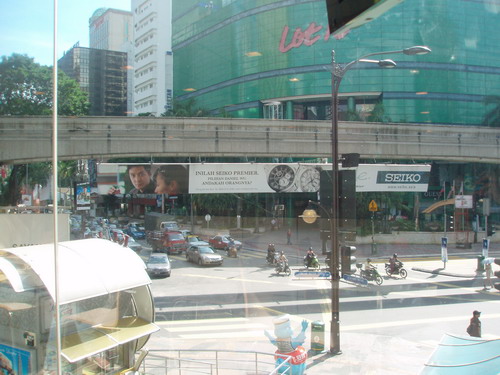On the morning of the last day of our stay in Kuala Lumpur, Malaysia, we had breakfast at McDonald’s located at the junction of Jalan Bukit Bintang. We sat on the top floor next to the window; the monorail and traffic intersection were in full view. One of the things that caught my attention was the languages used on billboard advertisements on the streets.
Advertising languages are good indicators of the commonly spoken languages of the city, town or village you visit. This has nothing to do with brands because brand names stay the same wherever they go: Coca Cola, McDonald’s and Kentucky Fried Chicken. Of course some countries like China will translate these brand names into Mandarin languages so they can be written and spoken more accurately by the natives. But the translation is never far from the way it originally sounds in English or the parent language.
The advertising language referred here is the text used to call for people’s attention to the message on the advertisement. I was intrigued by the words used. The billboard that was hung right underneath the monorail track and stood right above the middle of the traffic intersection, belonged to Seiko, a famous brand name of wrist watch. The text is in Malay and it says, “Inilah Seiko Premier” which when translated, simply means “This is Seiko Premier”.
It tells me two things. One is that the advertisers are definitely not targetting people who cannot speak Malay. Henceforth, the majority of Malaysians in this district speak Malay but are not necessarily Malay people as we do know Chinese, Indians and Expats also can also speak Malay. Malay then is one of the preferred languages of the local people. The second thing is that, the brand Seiko must have been present in this country for a very long time. This brand Seiko being the brand on my family’s wall clock and also in our study at home now.
There were two other advertisements on the pillars of which held the monorail tracks but they were both in English. One says, “Ellese, Perform with style.” To me, this reflects the present generation of people who are more likely to be bilingual in both Malay and English. Seiko is an old but reliable brand. Should I say, Ellese is not old and not reliable? Maybe it is not. It is just that when I see two billboard advertisements on watches, one written in the national Malay language and the other in English, and to my personal knowledge, Seiko has made its presence decades before Ellese, I am inclined to deduce that the natives are bilingual in both Malay and English, but the majority of the people here will understand Malay better than English.
The theory of using billboard advertisements to spot the preferred language of the local majority seems to work in other parts of the city. Near the KLCC, or Kuala Lumpur Convention Centre where the Twin Tower is located, all advertisements are written in English. When I went to buy bread at the supermarket, the cashiers spoke to me in English but spoke only Cantonese to her colleagues. When we travelled on the hop-on hop-off shuttle bus, the guides spoke to us in English.
Travelling around Kuala Lumpur was very easy as a result. Malay and English are two languages that I know well and could even use to make a bargain at the shopping mall. So next time you travel to a new city, try to spot the preferred language of the native people with billboard advertisements. You might save yourself lots of time and money on your trip.
The other places you can spot preferred language of natives:
– street names: Jalan, Road, Gang, Lorong, Jie (in Mandarin)
– names of shops located on the common streets not tourist shopping malls.
Places where advertisements are not targeted to local people may include the airport, hotels and tourist spots.




Interesting observations. But sometimes advertisements target the moneyed (or elite) and so have nothing to do with the majority (if they are poor)
The cost of advertising billboards internationally is very expensive: the panel, artwork and other creatives. This post is intended to help language learners understand how to make use of the environment they live in or visit for languages. Words on billboards, road signs and road names such as brand names are commonly regarded as sight words for children to learn to read.
I agree that the poor cannot afford to buy the expensive products shown here. Yet, it remains a resource for learning about the environment and reading practice.
I used to learn to read Mandarin with shop signs and packagings.
interesting..thank you..your observation has somehow help me with me research project on linguistic landscape ^^
That is very good! I am glad it supports your work.